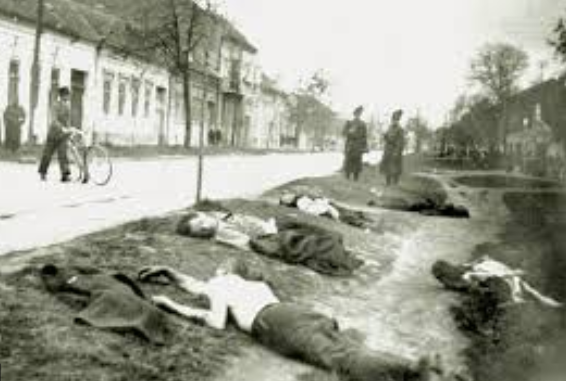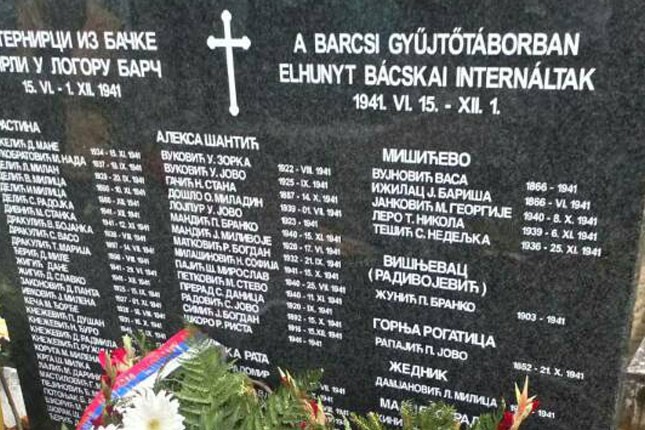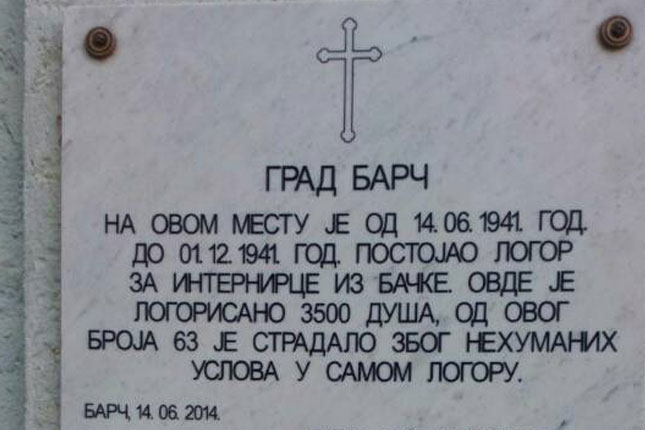|
|
Period:
Second World War
Region:
Hungary
The Hungarian camp in Barcs 1941
The Barcs Internment Camp was one of many concentration camps formed during World War II on Hungarian territory, in its south-western areas.
This camp was established in June 1941 under the instruction of Hungarian high command and with the knowledge of Hungarian high authorities, the Government, Parliament, and regent Miklós Horthy.
Through this collective camp, thousands of people, mainly civilians passed, mostly internees from Baranja and Bačka regions which were part of the Danube Banovina of the Kingdom of Yugoslavia.
This dungeon of death was a part of a genocidal plan for eradicating Serbs and Jews from the aforementioned areas which Hungarian extremist circles claimed as their “historical” right.
The Barcs camp was closed at the beginning of December 1941, and its inmates were transferred to the Sárvár camp.
In Barcs, after many decades upon the end of World War II, a small, modest monument was created in memory of the innocent victims, who were arrested without any court orders or verdicts. The fact that they were Serbs was enough for arrest.
BACKGROUND
The Kingdom of Serbs, Croats, and Slovenians, the first South Slavic state, later renamed into the Kingdom of Yugoslavia, was created after the First World War, with its promulgation on December 1, 1918, in Belgrade. The territory of the Yugoslav Kingdom was divided into banates in 1929 and the structure of its government was a parliamentary monarchy.

Proclamation of the first South Slavic state
The royal title was held by the Serbian Karadjordjević dynasty. It consisted of Southern Serbia, Šumadija, Raška, Kosovo and Metohija, Eastern Serbia, Montenegro, Bosnia and Herzegovina, Vojvodina, Slavonija, a small part of Dalmatia, the Dubrovnik Republic, Lika, Kordun, Banija, Zagorje, Gorski Kotar, and Slovenia.
After the assassination of King Alexander I Karadjordjević in Marseilles on October 9, 1934, the country was ruled by regents: Prince Paul Karadjordjević, Dr. Radenko Stanković, and Dr. Ivo Perović, and the government was formed by Dragiša Cvetković and Vlatko Maček.

Belgrade's demonstration on March, 1941.
In the mid-1930s, Europe witnessed the rise of Nazism and Fascism, especially in Germany, Italy, and Spain. This led to the formation of the Tripartite Pact, on September 27, 1940, between Germany, Italy, and Japan. In the next months, this alliance was joined by the following countries: Hungary, Bulgaria, Romania, Albania, etc. Thus, the Kingdom of Yugoslavia found itself surrounded by Axis Powers.
In Vienna, on March 25, 1941, the signing of the protocol between the Kingdom of Yugoslavia and Nazi Germany took place regarding the passage of German and Italian troops through Yugoslav territory. Among the patriotic forces of the Kingdom of Yugoslavia, this was interpreted as treason, and the British and Soviet intelligence officers organized a military coup and demonstrations on March 27, 1941 in Belgrade resulting in the overthrow of the governorship led by Prince Paul and putting on the throne a minor king Petar II Karadjordjević.
Hitler changed the plans and the armed forces' plans to attack Greece, were diverted to the Kingdom of Yugoslavia.
ESTABLISHMENT
The Barcs camp was established on 14th June 1941 by Hungarian military authorities in South-Western areas of the Kingdom of Hungary, 250 km (155 miles) from Budapest, and 240km (149 miles) North-West from Novi Sad.
Results of Hungarian exterminations in Sombor, April 1941.

Result of hungarian ethnic cleansing in Backa: Killed Serbs on Sombor's road
The inmates were brought from areas of the occupied Kingdom of Yugoslavia, that is North-Western areas of the Danube Banovina, which consisted of, among others, Baranja and Bačka.
Under the instruction of Miklós Horthy, heir to the Kingdom of Hungary, and Adolf Hitler’s subject, Hungarian occupational forces began with the eradication of Serbs, arresting and bringing them into camps, and murders, burglaries, burning of properties.
On the list for executions were people who began living there after 31st October 1918, mainly participants of World War I “Solunci” (Serbian soldiers from the Macedonian front), Orthodox priests, members of the falcon societies. It was estimated that during the occupation of Baranja and Bačka, 3.500 Serbs were killed.
The Declaration of Hungarian occupational forces on 25th April 1941, which was issued by general Ferenc Bayor in Novi Sad was as follows:
- “Every person of Serbian, Roma and Jewish ethnicity, who before 31st October 1918 did not have a municipal homeland on the territory of the greater Hungary (without Croatia), and are not relatives of such individuals, in other words, who are immigrants or colonists, are to leave the country in the next 3 three days, starting from 29th April 1941 at 00:00 am”.
Hungarian authorities also led violent expulsions of Serbs from Bačka by sending them under guard to Srem, where Ustasha would send them back.
After expelling people from their homes, Hungarians placed the leftover volunteers from the Macedonian front as well as their children into around 40 collective camps all around Bačka, from which they were transported by cattle wagons into Sárvár, Barcs, and Kanjiža.
CAMP CONDITIONS
As in every other camp, Barcs was horrible, because the filth ruled and inmates did not have proper medical care.
CLOSURE
The Barcs Camp was closed on 1st December 1941 under the orders of Hungarian high command, while other inmates were transferred to Sárvár.

Killed Serbs of Backa: Memorial plaque with a list of victims in Barcs
YEARS LATER
After more than 70 years from the closure of this dungeon of death in the town of Barcs, only one marble plate was placed which holds a short inscription from the time of the camp’s operation and the number of people held there. This was done on the initiative of the community of respectable descendants and admirers of the Macedonian Front Volunteers.

Not one nationality of the inmates, or the victims, or who was responsible for its establishment was mentioned.
An Orthodox cross was placed. The inscription was finished by the words “We did not forget you”.
The inscription was written in the Hungarian language, too.
There is a collective grave at the local cemetery, which lists 63 Serbian names of the people who left their bones there in 1941.
Municipal delegations from the places in Bačka from which Serbs were brought in, as well as other societies, organizations that cherish the memories of World War II, victims, and the Holocaust, every mid-June come to visit and place wreaths in memory of the terrible horrors suffered by innocent victims who were taken away.
PUBLICATIONS
Not a single film was made about the Barcs camp to this day. Several documentaries were filmed in which the Barcs camp was only mentioned.
Also, a book was written which mentions the Hungarian camp for Serbs in Barcs, but not one has exclusively covered this specific dungeon.
Tags:
Please, vote for this article:
Visited: 2554 point
Number of votes: 5
|